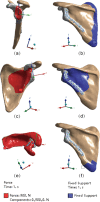Finite element analysis of a novel anatomical locking plate for scapular neck fracture
- PMID: 37004037
- PMCID: PMC10067195
- DOI: 10.1186/s13018-023-03743-3
Finite element analysis of a novel anatomical locking plate for scapular neck fracture
Abstract
Objectives: Reconstruction plates (RPs) are commonly used in scapular neck fractures (SNFs): however, RPs have many defects. In this study, we evaluated a newly designed scapular neck anatomical locking compression plate (SNALCP).
Methods: An SNF finite element model (Miller-type IIB) was constructed. Plates were subsequently implanted into the scapula and fixed with screws that were grouped according to the plate used: SNALCP (A) and RP (B). Finally, loads were applied to record and analyze performance.
Results: Under lateral, anteroposterior, and vertical compression loads, the maximum von Mises stresses on the scapula and implants of group A were smaller than those of group B. There were some differences in stress distribution between the two groups.
Conclusions: SNALCP can effectively reduce the stress of the scapula and implant, making stress distribution more uniform and continuous, and has mechanical conduction advantages. Compared to RP, it provides improved stability and more reliable fixation.
Keywords: Anatomical locking plate; Biomechanical characteristics; Finite element analysis; Reconstruction plate; Scapular neck fractures.
© 2023. The Author(s).
Conflict of interest statement
The authors declare that they have no conflicts of interest.
Figures






References
-
- Bartoníček J, Tuček M. Infraglenoid fracture of the scapular neck fact or myth? Rozhl Chir. 2019;98(7):273–276. - PubMed
MeSH terms
Grants and funding
- 2021-JYJ-60/the Luzhou Science and Technology Bureau Project
- 2021-JYJ-60/the Luzhou Science and Technology Bureau Project
- 2021-JYJ-60/the Luzhou Science and Technology Bureau Project
- 2021-JYJ-60/the Luzhou Science and Technology Bureau Project
- 2021-JYJ-60/the Luzhou Science and Technology Bureau Project
- 2021-JYJ-60/the Luzhou Science and Technology Bureau Project
- 2021-JYJ-60/the Luzhou Science and Technology Bureau Project
- 2022NSFSC1534/the Natural Science Foundation of Sichuan Province
- 2022NSFSC1534/the Natural Science Foundation of Sichuan Province
- 2022NSFSC1534/the Natural Science Foundation of Sichuan Province
- 2022NSFSC1534/the Natural Science Foundation of Sichuan Province
- 2022NSFSC1534/the Natural Science Foundation of Sichuan Province
- 2022NSFSC1534/the Natural Science Foundation of Sichuan Province
- 2022NSFSC1534/the Natural Science Foundation of Sichuan Province
LinkOut - more resources
Full Text Sources
Medical

